Vietnam Container Glass Market Size
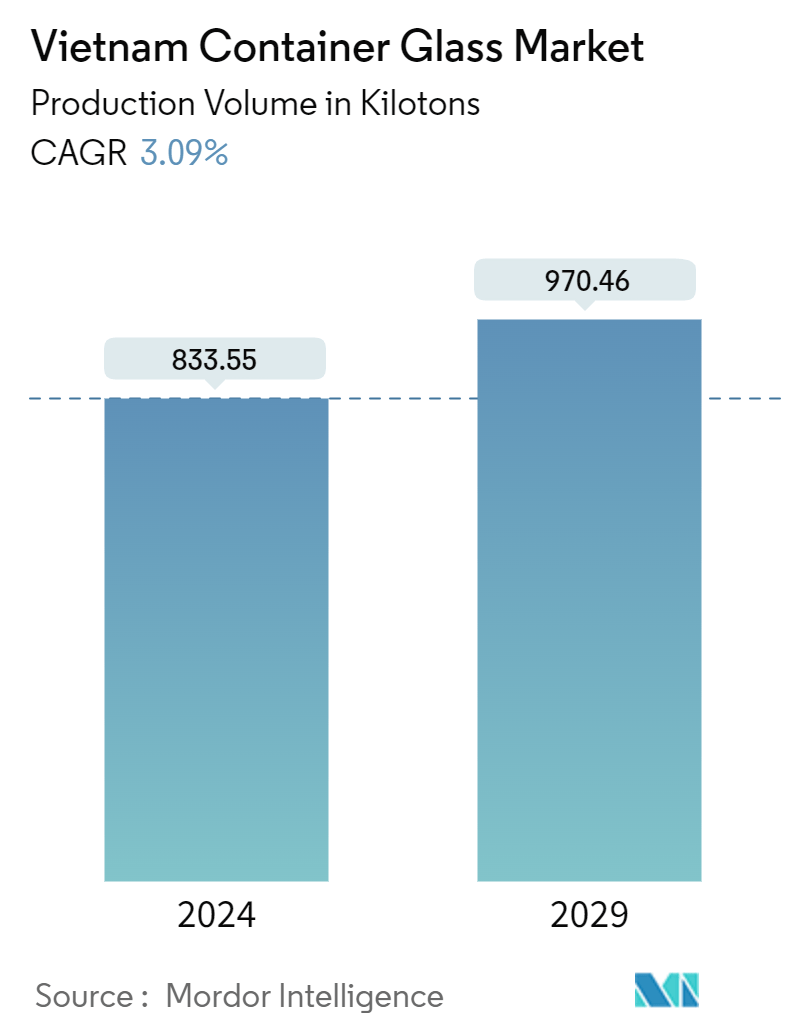
| Study Period | 2019 - 2029 |
| Base Year For Estimation | 2023 |
| Forecast Data Period | 2024 - 2029 |
| Historical Data Period | 2019 - 2022 |
| CAGR (2024 - 2029) | 3.09 % |
| Market Concentration | Low |
Major Players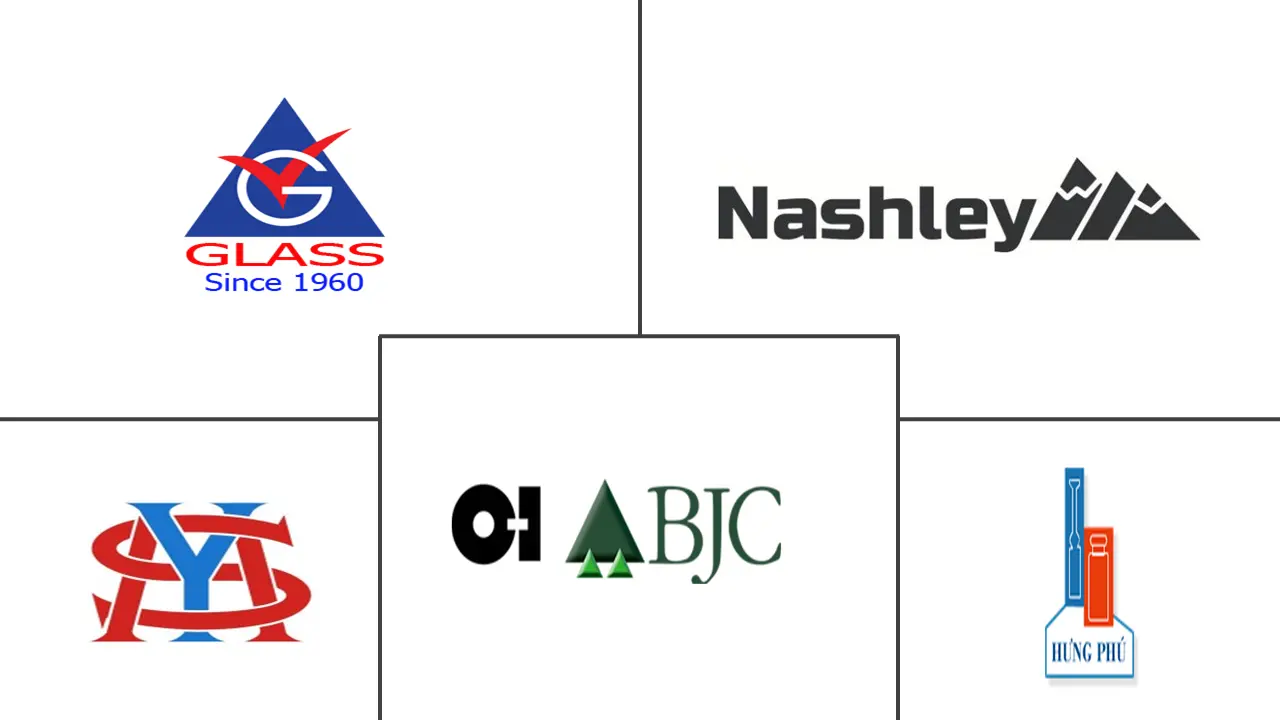
*Disclaimer: Major Players sorted in no particular order |
Vietnam Container Glass Market Analysis
The Vietnam Container Glass Market size in terms of production volume is expected to grow from 833.55 kilotons in 2024 to 970.46 kilotons by 2029, at a CAGR of 3.09% during the forecast period (2024-2029).
The rising consumer preferences for safe and eco-friendly packaging are propelling the growth of glass packaging across various segments in Vietnam. Additionally, technological advancements, including embossing, shaping, and artistic finishes, enhance the appeal of glass packaging.
- Notably, the escalating demand for eco-conscious solutions and a surging appetite from the food and beverage sector are further fueling Vietnam's glass packaging market. The market is also benefiting from increased investments in research and development, which are driving innovations in glass packaging.
- This transition is chiefly propelled by two factors: the swift growth of the middle class and the country's predominantly youthful population. With convenience stores, coffee shops, snack outlets, and the more comprehensive retail and hospitality landscape thriving, the demand for glass bottle packaging is poised for a significant upswing.
- Extended Producer Responsibility (EPR) is an environmental policy approach in which a producer's responsibility for a product is extended to the post-consumer stage of a product's life cycle. EPR policies require producers to take responsibility for the entire lifecycle of their products, including the post-consumer stage.
- Consumers are increasingly aware of the environmental impact of packaging materials. Glass is recyclable and perceived as a more sustainable option compared to plastics. This preference for environmentally friendly packaging can drive up the demand for container glass.
- Materials like plastic offer greater design and functionality flexibility than glass. For instance, plastic can be molded into various shapes and sizes more easily than glass, which might appeal to companies looking to differentiate their products.
Vietnam Container Glass Market Trends
Increasing Beverage Consumption in the Country to Drive the Market
- Consumers are increasingly aware of the environmental impact of packaging materials. Glass is recyclable and perceived as a more sustainable option compared to plastics. This preference for environmentally friendly packaging can drive up the demand for container glass.
- With the increase in beverage consumption, there is a higher demand for beverage packaging solutions, including glass bottles. Glass is a preferred packaging material for many types of beverages, including soft drinks, beer, wine, and spirits, due to its ability to preserve taste and quality, According to General Statistics Office of Vietnam, It was approximated that Vietnam produced about 4.5 billion liters of beer in 2023.
- Flavored sparkling water is often marketed as a premium, health-conscious beverage. Consumers looking for unique and exotic flavors are likely to prefer premium packaging that maintains the quality and taste of the product. Glass bottles are ideal for this purpose due to their non-reactive nature, preserving the beverage's flavor and carbonation better than plastic.
- Brands can use container glass to differentiate their products in a crowded market. Glass bottles offer a clean, aesthetic appeal that can be enhanced with unique designs, colors, and labeling. This helps brands stand out on the shelves and attract more consumers, thereby increasing the demand for glass packaging.
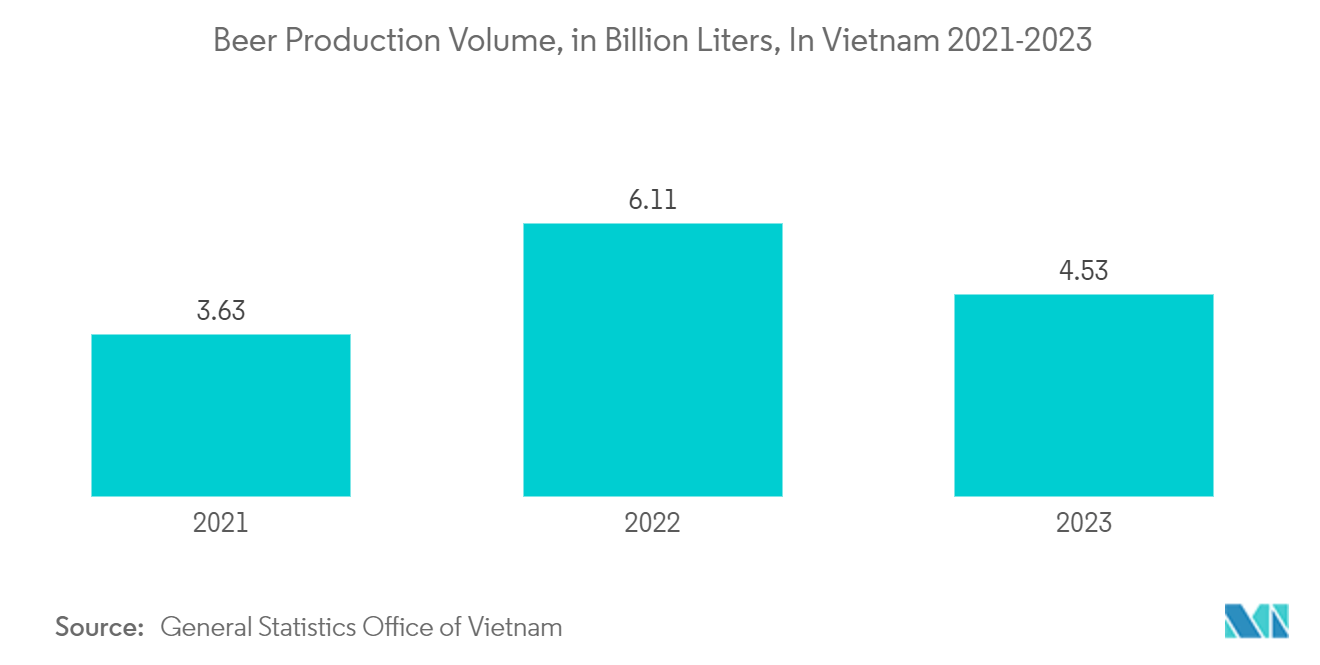
Wine and Spirits Segment to Witness Major Growth
- As consumers in Vietnam shift toward more sustainable lifestyles, including reducing plastic waste, the wine and spirits market in glass bottles is poised for growth. Glass bottles are perceived as more environmentally friendly than plastic, appealing to eco-conscious consumers and conveying a higher quality product. This trend attracts consumers willing to pay a premium for sustainability. Potential government regulations to reduce plastic usage could further boost demand for glass bottles.
- Higher taxes will likely lead to increased prices for alcoholic beverages. This could reduce overall consumption as consumers might cut back on purchases due to higher costs.
- Vietnam is set to increase its alcohol consumption tax from the current 65% to a staggering 100% by 2030. This tax, which primarily targets luxury goods and non-essential items, notably impacts both beer and strong liquor.
- The premium segment, often packaged in glass bottles, might be less affected as its consumers are typically less price-sensitive. Brands in this segment may emphasize their quality and environmental credentials to maintain demand.
- The significant increase in sales demonstrates strong market potential and consumer interest, encouraging manufacturers to invest more in glass packaging due to its premium appeal and environmental benefits.
- According to Invest & Export Brasil, in 2023, the retail sales of alcoholic beverages in Vietnam were around USD 3.1 billion when compared to 2019, which was USD 2.6 billion.
- As retail sales grow, there is likely an increased demand for premium alcoholic beverages, often packaged in glass bottles. Consumers may prefer higher-quality and premium-looking products, boosting sales in this segment.
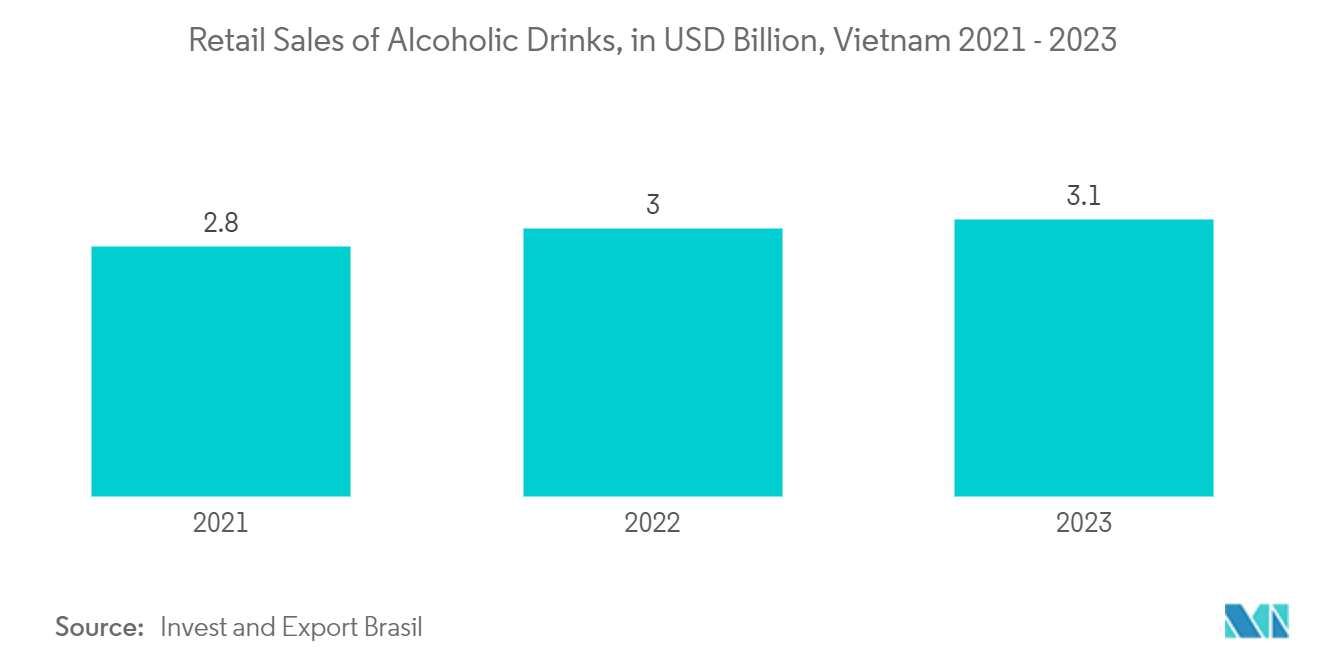
Vietnam Container Glass Industry Overview
The Vietnam container glass market is fragmented, as the major factors governing this force are a sustainable competitive advantage through innovation, levels of market penetration, barriers to exit, power of competitive strategy, and firm concentration ratio. Some of the players include O-I BJC Vietnam Glass Co., Go Vap Glass, HuphuMeglass, Nashley Technology Joint Stock Company, and Feemio Group Co. Ltd.
- September 2023 - Bia Viet launched an enhanced version, infusing it with distinct Vietnamese flavors and a revamped look. This updated Bia Viet iteration is resolute in its commitment to encapsulate the spirit of the Vietnamese populace in its brew.
Vietnam Container Glass Market Leaders
-
O-I BJC Vietnam Glass Co.
-
San Miguel Yamamura Packaging Corporation
-
HuphuMeglass
-
Go Vap Glass
-
Nashley Technology Joint Stock Company
*Disclaimer: Major Players sorted in no particular order
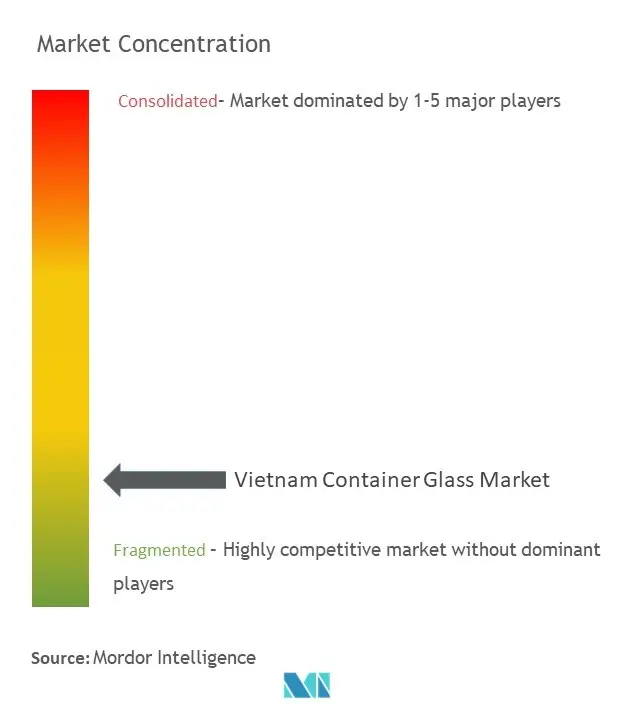
Vietnam Container Glass Market News
- April 2024 - Suntory PepsiCo Vietnam Beverage, a collaboration between Japan's Suntory and the United States-based PepsiCo, initiated the construction of a USD 300 million facility in Long An, a province in southern Vietnam.
- December 2023 - The Vietnam Ministry of Health (MoH) proposed a new Decree aimed at enhancing the management of cosmetics. The MoH has formally submitted the necessary documentation to the Government, seeking feedback and approval for the proposed Decree. The new Decree is likely to impose stricter quality and safety standards on cosmetic products. Glass jars, which are inert and do not interact with their contents, are often preferred for their ability to maintain the integrity of high-quality cosmetic formulations. As a result, stricter regulations could lead to an increased preference for container glass packaging.
Vietnam Container Glass Market Report - Table of Contents
1. INTRODUCTION
- 1.1 Study Assumptions and Market Definition
- 1.2 Scope of the Study
2. RESEARCH METHODOLOGY
3. EXECUTIVE SUMMARY
4. MARKET INSIGHTS
- 4.1 Market Overview
-
4.2 Industry Attractiveness - Porter's Five Forces Analysis
- 4.2.1 Bargaining Power of Suppliers
- 4.2.2 Bargaining Power of Consumers
- 4.2.3 Threat of New Entrants
- 4.2.4 Intensity of Competitive Rivalry
- 4.2.5 Threat of Substitute Products
- 4.3 Industry Ecosystem Analysis with Emphasis on Circular Economy
- 4.4 Industry Standards and Regulations for Glass Packaging in Vietnam
- 4.5 Raw Material Price Trend Analysis Cullet, Sand, and Container Glass
- 4.6 Trade Analysis
- 4.7 Vietnam Container Glass Industry
5. MARKET DYNAMICS
-
5.1 Market Drivers
- 5.1.1 Growing Environmental Awareness among the Population in Response to Extended Producer Responsibility (EPR)
- 5.1.2 The Increasing Beverage Consumption in the Country
-
5.2 Market Restraints
- 5.2.1 Alternative Packaging Options Challenging the Market Growth
6. SUBSTITUTION INSIGHTS OF GLASS BOTTLES WITH ALTERNATIVES
7. ECONOMIC ANALYSIS OF GLASS COLLECTION AND RECYCLING
8. MARKET SEGMENTATION
-
8.1 By End-user Industry
- 8.1.1 Beverage
- 8.1.1.1 Alcoholic
- 8.1.1.1.1 Beer and Cider
- 8.1.1.1.2 Wine and Spirits
- 8.1.1.1.3 Other Alcoholic Beverages
- 8.1.1.2 Non-Alcoholic
- 8.1.1.2.1 Carbonated Soft Drinks
- 8.1.1.2.2 Milk
- 8.1.1.2.3 Water and Other Non-alcoholic Beverages (Juices, Among others)
- 8.1.2 Food
- 8.1.3 Cosmetics
- 8.1.4 Pharmaceuticals
- 8.1.5 Other End-user Industries
9. COMPETITIVE LANDSCAPE
-
9.1 Company Profiles
- 9.1.1 O-I BJC Vietnam Glass Co.
- 9.1.2 San Miguel Yamamura Packaging Corporation
- 9.1.3 Go Vap Glass
- 9.1.4 HuphuMeglass
- 9.1.5 Nashley Technology Joint Stock Company
- 9.1.6 Ardagh Group
- 9.1.7 Gerresheimer AG
- *List Not Exhaustive
10. FUTURE OUTLOOK OF THE MARKET
** Subject To AvailablityVietnam Container Glass Industry Segmentation
The market is defined in terms of consumption sales of various container glasses such as bottles, jars, vials, and ampoules offered by various vendors operating in the market. The consumption volume (kilo tonnes) of the Vietnam container glass market is considered for the market size and forecasts. The market study factors are based on the prevalent base scenarios, key themes, and end-user vertical-related demand cycles.
The Vietnam container glass market is segmented by end-user industry (beverages (alcoholic (beer and cider, wine and spirits, and other alcoholic beverages), non-alcoholic (carbonated soft drinks, milk, water and other non-alcoholic beverages (juices, among others)), food, cosmetics, pharmaceuticals, other end-user industry). The Market Sizes and Forecasts are Provided in Terms of Value (USD) for all the Above Segments.
| By End-user Industry | Beverage | Alcoholic | Beer and Cider |
| Wine and Spirits | |||
| Other Alcoholic Beverages | |||
| By End-user Industry | Beverage | Non-Alcoholic | Carbonated Soft Drinks |
| Milk | |||
| Water and Other Non-alcoholic Beverages (Juices, Among others) | |||
| By End-user Industry | Food | ||
| Cosmetics | |||
| Pharmaceuticals | |||
| Other End-user Industries |
Vietnam Container Glass Market Research FAQs
How big is the Vietnam Container Glass Market?
The Vietnam Container Glass Market size is expected to reach 833.55 kilotons in 2024 and grow at a CAGR of 3.09% to reach 970.46 kilotons by 2029.
What is the current Vietnam Container Glass Market size?
In 2024, the Vietnam Container Glass Market size is expected to reach 833.55 kilotons.
Who are the key players in Vietnam Container Glass Market?
O-I BJC Vietnam Glass Co., San Miguel Yamamura Packaging Corporation, HuphuMeglass, Go Vap Glass and Nashley Technology Joint Stock Company are the major companies operating in the Vietnam Container Glass Market.
What years does this Vietnam Container Glass Market cover, and what was the market size in 2023?
In 2023, the Vietnam Container Glass Market size was estimated at 807.79 kilotons. The report covers the Vietnam Container Glass Market historical market size for years: 2019, 2020, 2021, 2022 and 2023. The report also forecasts the Vietnam Container Glass Market size for years: 2024, 2025, 2026, 2027, 2028 and 2029.
Vietnam Glass Industry Report
Statistics for the 2024 Vietnam Glass market share, size and revenue growth rate, created by Mordor Intelligence™ Industry Reports. Vietnam Glass analysis includes a market forecast outlook 2029 and historical overview. Get a sample of this industry analysis as a free report PDF download.



